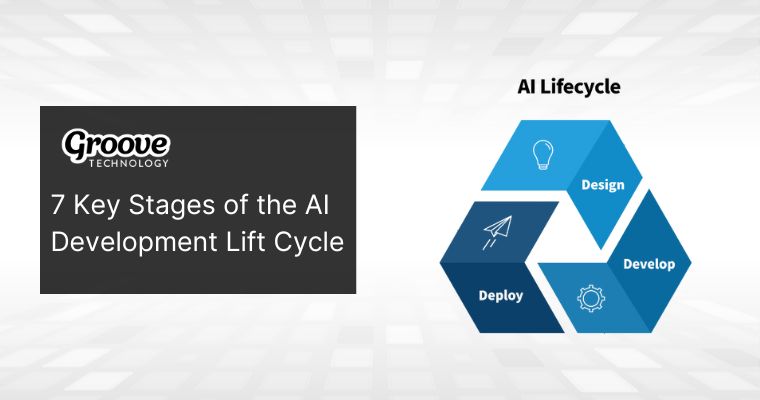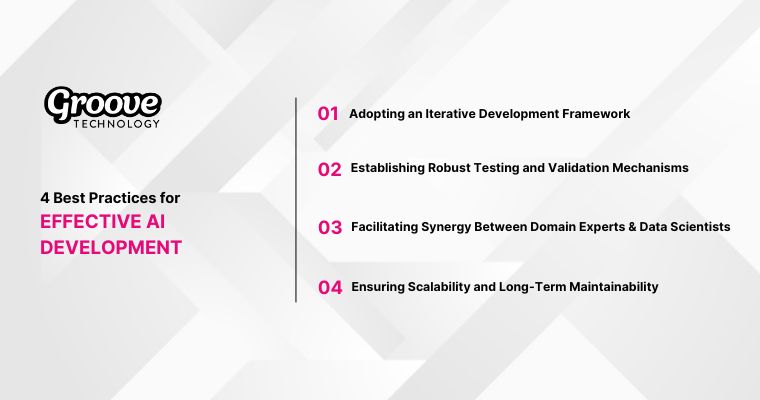The Complete Guide to AI Development Lifecycle and Model Management
The AI development lifecycle is a systematic approach to the design, development, deployment, and maintenance of artificial intelligence systems. This complex process consists of seven stages, from problem recognition to continuous management, requiring a unique methodology due to its data-centric nature, iterative refinement, and complex model behavior.
The deployment and integration stages play a critical role in transforming theoretical AI models into practical tools in an operational ecosystem. Deployment strategies include cloud hosting, edge device development, or a combination of both to balance performance and scalability.
The AI development cycle begins with problem definition, followed by data collection and preparation. Then comes model selection and training, where machine learning algorithms are selected and tuned. Model accuracy and reliability are evaluated and validated. The development phase brings the AI solution to life, while ongoing monitoring and maintenance ensure its effectiveness.
Weak design tools from TensorFlow and PyTorch for model development to Kubernetes for deployment orchestration are essential. AI measures the success of the project by tracking key performance indicators, assessing business operations, and safeguarding ethical practices.
Let’s dive into each phase to explore how to build an effective, scalable AI system that delivers new changes and delivers real-world value in the next section of the article.

What is the AI Development Lifecycle?
The AI Development Lifecycle refers to the systematic process of designing, developing, deploying, and maintaining AI systems. Unlike traditional software development, AI projects require unique approaches due to their reliance on data, iterative improvements, and complex model behaviors. Understanding this lifecycle is critical for successful AI implementation.

Key Characteristics of the AI Development Lifecycle
- Data-Centric Approach: Data underpins AI systems, shaping accuracy, functionality, and ethical alignment.
- Iterative Framework: Iteration drives enhancement—cycles of training, testing, and refining are constant.
- Interdisciplinary Synergy: Collaborations between data scientists, domain specialists, and software engineers are essential.
A well-structured lifecycle, include:
- Ensures Timeliness: Staged processes mitigate delays and optimise resource use.
- Supports Ethical Standards: By addressing biases and regulatory challenges early, risks are minimised.
- Optimises Resource Allocation: Efficiency is enhanced by clear, scalable procedures.
Comparing AI and Traditional Development
| Aspect | AI Development | Traditional Software |
| Data Dependency | Relies on extensive, quality datasets. | Minimal data integration. |
| Outcomes | Probabilistic, influenced by context. | Predictable, deterministic. |
| Testing | Requires real-world scenario testing. | Focuses on functional validation. |
7 Stages of the AI Development Lifecycle
The AI Development Lifecycle consists of distinct stages that guide teams from conceptualizing an AI solution to deploying and maintaining it. Each stage plays a vital role in ensuring the success and efficiency of the project. Below is an in-depth exploration of 7 stages:

Stage 1: Problem Definition and Business Goal Setting
Defining the problem and setting business goals is the foundational step in AI development. Establishing a clear problem statement and defining business goals are pivotal steps in the AI development lifecycle. These ensure the AI system's alignment with organisational objectives and focus on addressing precise challenges.
Core Activities:
- Identifying the Problem: Frame the issue succinctly, e.g., “How can we lower customer attrition in retail?” or “What strategies improve fraud detection in banking?”
- Setting SMART Goals: Create objectives that are Specific, Measurable, Achievable, Relevant, and Time-bound. For instance, “Enhance email campaign conversion rates by 15% within six months using AI.”
- Stakeholder Collaboration: Engage stakeholders to align priorities and define metrics for success.
Key Questions to Resolve:
- What specific challenge does AI aim to address?
- How will success be measured?
- What are the necessary resources (data, expertise, infrastructure)?
Case in Context: Consider a financial institution targeting a 20% reduction in fraudulent transactions. By pinpointing the problem, engaging relevant teams, and aligning on measurable outcomes, the project gains a focused trajectory.
Stage 2: Data Collection and Exploration
Data serves as the foundation for AI systems. Efficiently acquiring and analysing datasets is essential to build high-performing models.
Data Sources
- Internal Repositories: CRM, ERP, and operational data systems.
- External Platforms: APIs, public datasets, social media streams.
- Custom Data: IoT devices, bespoke data collection tools.
Performing EDA ensures data integrity and reveals valuable patterns. Key steps include:
- Assessing Data Integrity: Identifying gaps, anomalies, and potential biases.
- Visualising Trends: Understanding distributions through graphs and summaries.
- Tool Utilisation: Leverage Python libraries such as Pandas and Matplotlib, within environments like Jupyter Notebooks.
3 core metrics in this stage:
| Metric | Definition | Tools |
| Data Completeness | Absence of missing values. | Python, SQL |
| Data Bias | Dataset representativeness evaluation. | Fairlearn, AI Fairness 360 |
| Correlation Analysis | Uncovering relationships between variables. | Seaborn, Tableau |
Stage 3: Data Preparation and Preprocessing
Data preparation transforms raw data into a refined, usable format to optimise model accuracy and reliability. Robust preparation is essential to building effective AI systems. To prepare data effectively, focus on the following three key steps:
1. Data Cleaning
- Purpose: Eliminate irrelevant, incomplete, or incorrect entries.
- Methods:
- Remove duplicates and non-relevant entries.
- Address missing data through imputation (e.g., mean or median replacement) or elimination.
- Resolve inconsistencies (e.g., harmonising date formats like DD/MM/YYYY vs. MM/DD/YYYY).
- Example: Replace missing age data in a customer dataset (e.g., 10% missing) using the median value.
2. Data Transformation
- Purpose: Enhance uniformity for compatibility with algorithms.
- Methods:
- Normalise numerical values to scale data uniformly.
- Encode categorical values using techniques like one-hot encoding.
- Example: Convert “Yes/No” responses into binary values (1/0) for processing in machine learning pipelines.
3. Feature Engineering
- Purpose: Create and refine features to maximise model insights.
- Methods:
- Extract and generate features (e.g., “day of the week” from a date for sales forecasting).
- Combine variables for enhanced significance.
However, this process is not without significant challenges, include:
- Large Data Volumes: Efficiently managing billions of records.
- Imbalanced Datasets: Mitigating bias in classification tasks (e.g., fraud detection with only 1% fraudulent transactions).
- Data Privacy: Ensuring compliance with GDPR or similar regulations during sensitive data handling.
To limit the risks from the above challenges, below are common techniques and support tools in the data processing process at this step.
| Technique | Purpose | Tools |
| Imputation | Address missing values | Scikit-learn, KNNImputer |
| Normalisation | Standardise data scales | MinMaxScaler, TensorFlow |
| Synthetic Oversampling | Balance imbalanced datasets | SMOTE, Imbalanced-learn |
By rigorously cleaning, transforming, and enriching data, organisations lay a strong foundation for building scalable, high-performing AI models.
Stage 4: Model Architecture Design and Development
Designing and constructing the AI model constitutes a core stage of the AI lifecycle, where architectural choices significantly affect the system’s performance and scalability. Let’s begin by exploring how algorithm choices align with problem domains.
Algorithm Selection – Algorithms must align with the problem domain:
- Regression Problems: Options include Linear Regression or Random Forest.
- Classification Tasks: Techniques like Logistic Regression or Support Vector Machines.
- Deep Learning Use Cases: Employ Convolutional Neural Networks (CNNs) for image tasks and Recurrent Neural Networks (RNNs) for sequential data.
Next, we’ll delve into whether a custom or pre-trained model suits your needs best:
- Custom Models: Developed for bespoke datasets and tailored objectives.
- Pre-Trained Models: Leverage models like BERT for natural language or ResNet for image tasks, saving on computation and time.
Finally, let’s consider the iterative process crucial for refining your model.
- Experiment with various configurations and parameters (e.g., learning rate, batch size).
- Use hyperparameter tuning frameworks such as Keras Tuner or Optuna.
Moreover, let’s examine the key factors ensuring optimal model design and deployment:
- Computational Resources: Select resource-efficient strategies like cloud solutions (AWS, Azure) to balance cost and performance.
- Model Explainability: Opt for interpretable models, especially in sensitive domains like healthcare or finance.
- Scalability: Design with future-proofing to accommodate data growth without excessive retraining overhead.
This concise strategy combines a focus on performance with alignment to business and ethical requirements.
Stage 5: Model Training and Testing
These stages involve teaching the AI system using structured data and evaluating its effectiveness in real-world conditions.
1. Data Preparation: Split the dataset into training, validation, and test sets, typically in ratios like 70-20-10 or 80-10-10.
2. Training:
- Introduce the model to the training data to uncover patterns.
- Use algorithms like Stochastic Gradient Descent (SGD) to adjust internal weights.
Example: A convolutional neural network learns to differentiate cats from dogs by identifying unique image features.
3. Regularisation:
- Avoid overfitting by employing techniques such as dropout layers or L2 regularisation.
- Overfitting occurs when the model excels in recognising training data but underperforms on new inputs.
4. Testing and Validation
- Cross-Validation: Apply k-fold cross-validation to evaluate consistency. For instance, with k=5, the dataset is divided into five parts, cycling one as the test set while the rest train the model.
- Performance Metrics: Choose evaluation metrics aligned with the problem
- Regression: Mean Absolute Error (MAE), R-squared (R²).
- Classification: Accuracy, Precision, Recall, F1-score, AUC-ROC.
Example: A diagnostic AI prioritises a high F1-score to balance false positives and negatives.
5. Hyperparameter Tuning: Refine parameters like learning rate and layer count using
- Grid Search.
- Random Search.
- Tools such as Scikit-learn GridSearchCV or Optuna.
Stage 6: Deployment and Integration
After achieving satisfactory performance, AI models transition from theoretical constructs to practical tools within operational ecosystems. This transformation hinges on seamless deployment and robust integration. Key strategies for deployment in this stage include:
- Cloud-Based Hosting: Leverage platforms such as AWS Sagemaker, Google AI Platform, or Azure ML to enhance scalability.
Example: A retail chatbot utilising AWS to provide real-time customer query handling. - Edge Deployments: Embed models on local devices, such as IoT systems or mobile devices, for low-latency processing.
Example: AI in autonomous vehicles for instantaneous decision-making. - Hybrid Approaches: Marry cloud and edge strategies for balanced performance and scalability.
In addition, there are some System Integration Techniques you can apply in this stage including:
- API Development: Design RESTful APIs to integrate AI functionalities into existing infrastructures.
Example: Connecting an AI recommendation engine to an e-commerce platform. - CI/CD Pipeline Implementation: Automate model iterations and deployments via CI/CD practices. Tools like Jenkins, Docker, and Kubernetes streamline this process.
Finally, some notes on post-deployment maintenance
- Monitoring and Analytics: Employ tools such as Prometheus and Grafana to assess latency, accuracy, and throughput.
- Addressing Model Drift: Regular updates to align with shifting data distributions safeguard relevance.
Stage 7: Continuous Monitoring and Improvement
Deploying an AI system marks the onset of an ongoing cycle of monitoring and refinement. As operational contexts, data landscapes, and user needs evolve, ensuring the system remains relevant and efficient is paramount.
First in this stage you need to understand the 3 important elements of continuous observation:
1. Performance Metric Analysis: Actively monitor indicators such as prediction accuracy, response latency, and resource utilisation.
Example: A fraud detection algorithm evaluates daily precision and recall rates to minimise errors like false positives.
2. Change Detection:
- Data Drift: Identifies shifts in data patterns that can impact model performance.
- Concept Drift: Adjusts for changing correlations between inputs and desired outcomes.
- Tools like Evidently AI and Alibi Detect are useful for diagnosing drift issues effectively.
3. Error Diagnosis: Analyse and learn from erroneous outputs to enhance model understanding and functionality.
Example: Refining an e-commerce recommender that inaccurately overpromotes niche products.
Next, you should also look for Improvement Frameworks to optimize performance during AI development, including:
1. Model Evolution: Leverage incremental updates to incorporate new data while preserving prior learning.
Example: Weather forecasting systems integrating the latest climate patterns for better accuracy.
2. User Feedback Loops: Integrate user suggestions to fine-tune the AI for improved real-world applicability.
Example: Adaptive conversational agents optimising their dialogue strategies based on user interaction logs.
3. Scheduled Retraining: Regularly update datasets and retrain models to align with new standards or expectations.
Example: Employing transfer learning to expedite retraining processes using foundational model weights.
Critical Challenges in the AI Development Lifecycle
Crafting AI solutions involves navigating intricate hurdles that affect performance, ethical integrity, and scalability. Proactive resolution of these challenges is essential for success.
1. Safeguarding Data Integrity and Accessibility
- Problem: Variability or gaps in datasets compromise model reliability.
- Remedy: Establish robust pipelines bolstered by automated quality-assessment protocols.
- Key Insight: Approximately 80% of data scientists' efforts focus on data preparation over model construction.
2. Optimising Algorithm and Architecture Selection
- Problem: Misaligned algorithms impair outcomes.
- Remedy: Prototype diverse methodologies to benchmark performance before production deployment.
3. Balancing Computational Demands
- Problem: Resource-intensive deep learning models strain infrastructures.
- Remedy: Utilise cloud-based GPU frameworks and refine code for computational efficiency.
4. Embedding Ethics and Neutrality
- Problem: Bias in systems risks inequity, especially in sensitive areas like hiring and healthcare.
- Remedy: Employ tools like Fairlearn to assess and address systemic biases in datasets and algorithms.
4 Best Practices for Effective AI Development
Implementing structured guidelines ensures AI projects align with performance expectations while addressing ethical, operational, and scalability challenges. These practices streamline workflows, foster collaboration, and drive successful outcomes.

1. Adopting an Iterative Development Framework
- Definition: Iteration refines models and processes using continuous feedback and performance indicators.
- Rationale: Mitigates risks through incremental improvements and adaptive learning.
- Example: A retail AI solution employs weekly iterations to refine pricing algorithms based on dynamic customer behaviour metrics.
2. Establishing Robust Testing and Validation Mechanisms
- Steps:
- Apply cross-validation for model reliability.
- Perform A/B testing against existing systems for comparative insights.
- Simulate edge cases to ensure resilience under extreme conditions.
- Guidelines:
- Use real-world datasets to validate usability.
- Maintain independent validation sets to prevent data leakage.
- Tools: Scikit-learn, PyTest.
3. Facilitating Synergy Between Domain Experts and Data Scientists
- Importance: Effective AI systems bridge technical expertise with domain-specific insights.
- Action Points:
- Conduct workshops to align technical goals with business strategies.
- Leverage platforms like Slack and Jira for seamless communication.
- Case in Point: In healthcare, clinicians partner with data scientists to ensure predictive models adhere to clinical standards.
4. Ensuring Scalability and Long-Term Maintainability
- Steps:
- Design modular codebases for adaptability.
- Implement containerisation (e.g., Docker) for deployment across environments.
- Employ scalable cloud solutions like AWS or Azure to manage data growth.
- Example: A fintech company leverages microservices to scale fraud detection systems during peak transaction periods.
Tools and Technologies in the AI Development Lifecycle
Adopting precise tools and systems can profoundly streamline AI project workflows. Below are critical tools categorised by lifecycle stages.
1. Data Collection and Preprocessing
- Objective: Acquire, clean, and structure raw data for model development.
- Tools:
- Pandas, NumPy: Essential for manipulating and analysing structured datasets.
- Apache Spark: Ideal for scalable, distributed data handling.
- ETL Pipelines: Automate the extraction, transformation, and loading of data.
2. Model Development Frameworks
- Objective: Facilitate model building, training, and experimentation.
- Frameworks:
- TensorFlow: Excellent for production-grade deep learning.
- PyTorch: Suited for research-centric projects requiring flexibility.
- Scikit-learn: A go-to for classical machine learning approaches.
- Comparison Table:
| Framework | Strengths | Optimal Use Case |
| TensorFlow | Scalability, comprehensive tools | Deep learning, large-scale AI |
| PyTorch | Adaptability, dynamic graphing | Rapid prototyping, R&D |
| Scikit-learn | Simplicity, diverse algorithms | Classical ML, initial models |
- Deployment and Monitoring
- Objective: Operationalise models and ensure sustained performance.
- Tools:
- Kubernetes: Streamlines model deployment, scaling, and orchestration.
- MLflow: Manages lifecycle stages, from experiment tracking to deployment.
- Prometheus & Grafana: Provide real-time metrics and observability dashboards.

Measuring Success in an AI Development Project
Achieving success in AI development transcends technical performance. It hinges on aligning outcomes with defined business objectives, assessing model efficacy, and ensuring iterative improvement.
1. Defining Key Performance Indicators (KPIs)
Technical Metrics:
- Core Measures: Accuracy, precision, recall, F1-score, and latency.
- Example: For fraud detection, sustaining an F1-score ≥ 0.85.
Business Objectives:
- Key Focus Areas: Enhanced revenue, cost efficiency, and customer satisfaction.
- Example: A recommendation algorithm boosting sales by 20%.
2. Analysing Model Effectiveness and Business Impact
Model Assessment:
- Employ test datasets and cross-validation to verify accuracy.
- Conduct real-world evaluations to confirm predictive validity.
Metrics and Their Applications:
| Metric | Description | Use Case |
| Precision | Proportion of true positives to predicted positives. | Spam filtering, fraud detection. |
| Recall | Proportion of actual positives correctly identified. | Medical diagnosis. |
| Latency | Time to generate predictions. | Real-time systems, e.g., chatbots. |
Business Impact Measurement:
- Compare metrics pre- and post-AI implementation to assess ROI.
- Example: A logistics AI reducing delivery time by 15%.
3. Ensuring Continuous Monitoring and Adaptive Strategies
Monitoring Framework:
- Use tools like Grafana to visualise metrics in real-time.
- Example: Track churn in AI-powered CRM systems.
Dynamic Retraining:
- Periodically retrain models with new data to sustain relevance.
- Tools: MLflow, Evidently AI.
Success in AI: Align goals, assess effectiveness, and ensure improvement.

Future Trends in the AI Development Lifecycle
As Artificial Intelligence (AI) evolves, the AI development lifecycle undergoes continuous transformation, integrating cutting-edge technologies, methodologies, and ethical frameworks. These advancements aim to enhance efficiency, accessibility, and reliability across AI systems.
1. Automated Machine Learning (AutoML)
AutoML automates intricate processes such as model selection, hyperparameter tuning, and feature engineering. It empowers non-specialists and accelerates AI development.
Key Functions:
- Streamlines AI model creation by reducing technical barriers.
- Enables swift iteration cycles for faster delivery.
Benefits:
- Shortens project timelines.
- Democratizes machine learning for small enterprises.
Examples:
- Google AutoML: Simplifies creating image recognition systems with minimal coding.
- Tools in Use:
- AI: A scalable open-source platform.
- DataRobot: Enterprise-grade automation tailored for business applications.
2. AI at the Edge and Distributed Learning
Emerging approaches like edge AI and distributed learning mitigate latency while addressing privacy concerns by decentralising data processing.
Edge AI:
- Runs algorithms on devices such as IoT gadgets and autonomous vehicles.
- Reduces dependence on cloud infrastructures.
- Example: Self-driving cars use edge computing for real-time navigation.
Distributed Learning:
- Trains models across localised datasets without transferring sensitive information.
- Example: Federated learning in Google Gboard maintains data privacy.
Impact Areas:
- Edge AI: Low-latency applications such as wearables and smart homes.
- Distributed Learning: Domains requiring robust data security, e.g., healthcare.
3. Integrating Explainable AI (XAI)
Explainable AI fosters transparency, enabling users to trust and understand machine decisions.
What is XAI?
- Provides clarity on algorithmic decision-making processes.
- Example: Explaining disease risk predictions in healthcare applications.
Advantages:
- Strengthens regulatory compliance (e.g., GDPR).
- Builds trust through transparency.
Tools:
- SHAP: Visual explanations for model outputs.
- LIME: Simplifies interpretation of complex algorithms.

The AI Development Lifecycle is a comprehensive framework that guides the successful creation, deployment, and maintenance of AI systems. Each stage, from problem definition to continuous monitoring, plays a vital role in ensuring the system's reliability, scalability, and ethical integrity.
As a leading software outsourcing provider, Groove Technology offers expertise in the AI Development Lifecycle. From data preparation to scalable deployment, our team is committed to delivering innovative solutions tailored to your business needs. Our experience across diverse industries ensures that your AI projects achieve measurable success.





